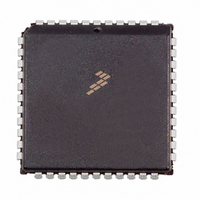MC68HC711D3CFNE3 Freescale Semiconductor, MC68HC711D3CFNE3 Datasheet - Page 54

MC68HC711D3CFNE3
Manufacturer Part Number
MC68HC711D3CFNE3
Description
IC MCU 8BIT 2MHZ 44-PLCC
Manufacturer
Freescale Semiconductor
Series
HC11r
Specifications of MC68HC711D3CFNE3
Core Processor
HC11
Core Size
8-Bit
Speed
3MHz
Connectivity
SCI, SPI
Peripherals
POR, WDT
Number Of I /o
26
Program Memory Size
4KB (4K x 8)
Program Memory Type
OTP
Ram Size
192 x 8
Voltage - Supply (vcc/vdd)
4.5 V ~ 5.5 V
Oscillator Type
Internal
Operating Temperature
-40°C ~ 85°C
Package / Case
44-PLCC
Lead Free Status / RoHS Status
Lead free / RoHS Compliant
Eeprom Size
-
Data Converters
-
Available stocks
Company
Part Number
Manufacturer
Quantity
Price
Company:
Part Number:
MC68HC711D3CFNE3
Manufacturer:
SGS
Quantity:
6 218
Company:
Part Number:
MC68HC711D3CFNE3
Manufacturer:
Freescale Semiconductor
Quantity:
10 000
5.4.2 Non-Maskable Interrupt Request XIRQ
5.4.3 Illegal Opcode Trap
5-10
Non-maskable interrupts are useful because they can always interrupt CPU opera-
tions. The most common use for such an interrupt is for serious system problems, such
as program runaway or power failure. The XIRQ input is an updated version of the
nonmaskable NMI input of earlier MCUs.
Upon reset, both the X bit and I bits of the CCR are set to inhibit all maskable interrupts
and XIRQ. After minimum system initialization, software can clear the X bit by a TAP
instruction, enabling XIRQ interrupts. Thereafter, software cannot set the X bit. Thus,
an XIRQ interrupt is a nonmaskable interrupt. Because the operation of the I-bit-relat-
ed interrupt structure has no effect on the X bit, the internal XIRQ pin remains non-
masked. In the interrupt priority logic, the XIRQ interrupt has a higher priority than any
source that is maskable by the I bit. All I-bit-related interrupts operate normally with
their own priority relationship.
When an I-bit-related interrupt occurs, the I bit is automatically set by hardware after
stacking the CCR byte. The X bit is not affected. When an X-bit-related interrupt oc-
curs, both the X and I bits are automatically set by hardware after stacking the CCR.
A return from interrupt instruction restores the X and I bits to their pre-interrupt request
state.
Because not all possible opcodes or opcode sequences are defined, the MCU in-
cludes an illegal opcode detection circuit, which generates an interrupt request. When
an illegal opcode is detected and the interrupt is recognized, the current value of the
program counter is stacked. After interrupt service is complete, reinitialize the stack
pointer so repeated execution of illegal opcodes does not cause stack underflow. Left
uninitialized, the illegal opcode vector can point to a memory location that contains an
illegal opcode. This condition causes an infinite loop that causes stack underflow. The
stack grows until the system crashes.
The illegal opcode trap mechanism works for all unimplemented opcodes on all four
opcode map pages. The address stacked as the return address for the illegal opcode
interrupt is the address of the first byte of the illegal opcode. Otherwise, it would be
almost impossible to determine whether the illegal opcode had been one or two bytes.
Table 5-5 Stacking Order on Entry to Interrupts
Freescale Semiconductor, Inc.
Memory Location
For More Information On This Product,
SP – 1
SP – 3
SP – 4
SP – 5
SP – 6
SP – 7
SP – 8
SP –2
SP
RESETS AND INTERRUPTS
Go to: www.freescale.com
CPU Registers
ACCA
ACCB
PCH
CCR
PCL
IYH
IXH
IYL
IXL
TECHNICAL DATA












